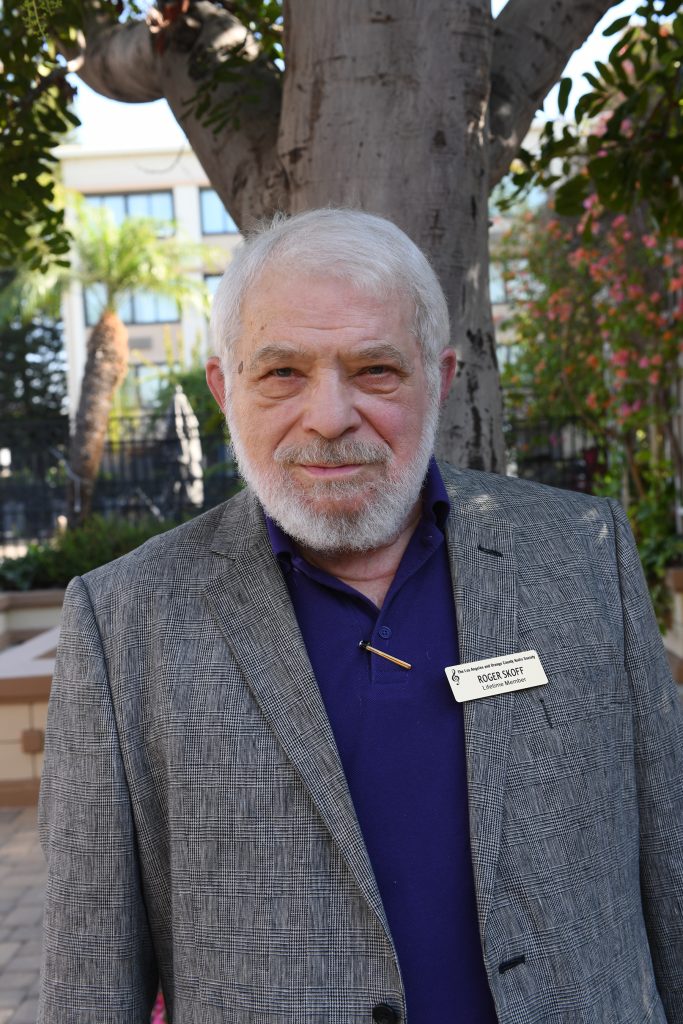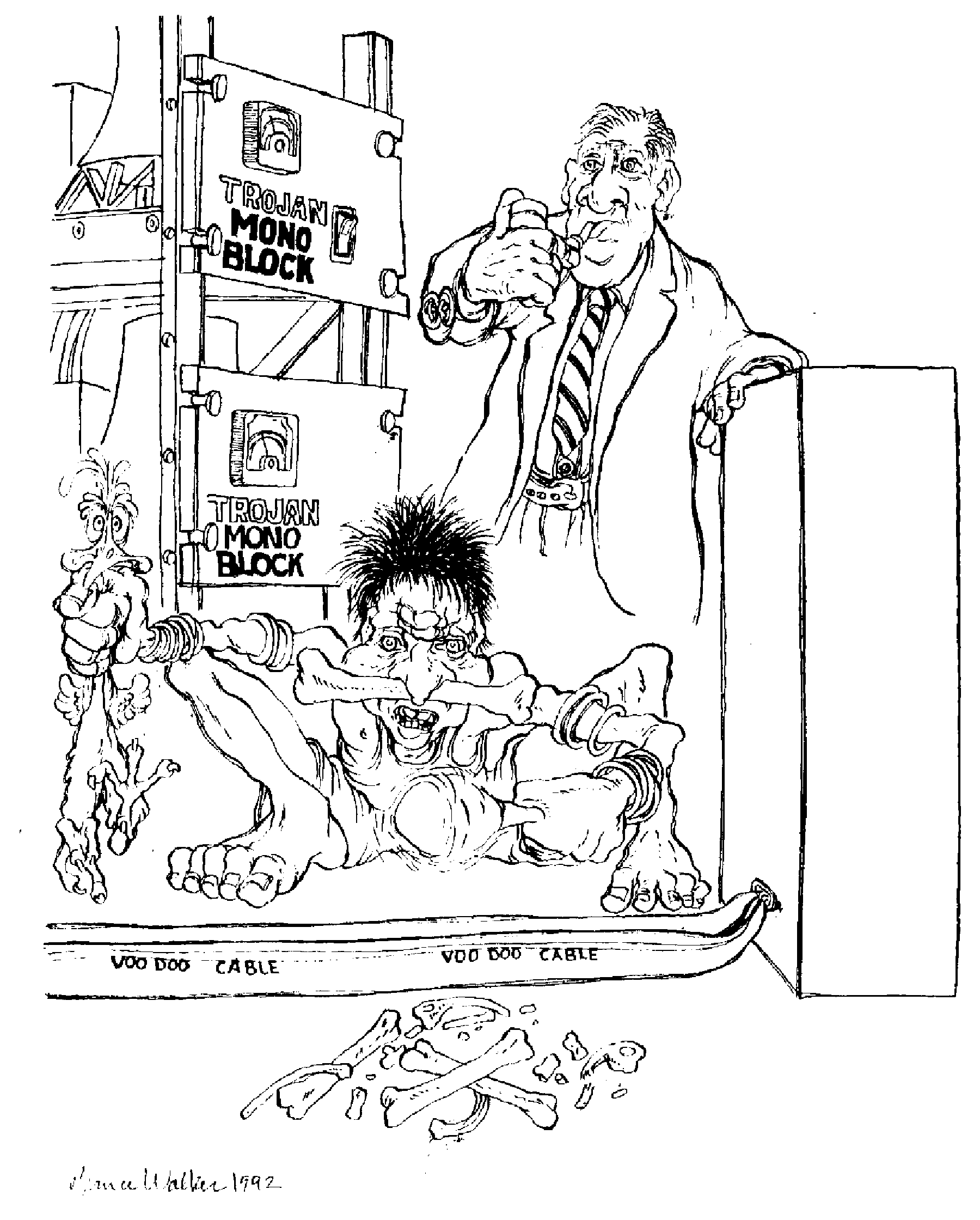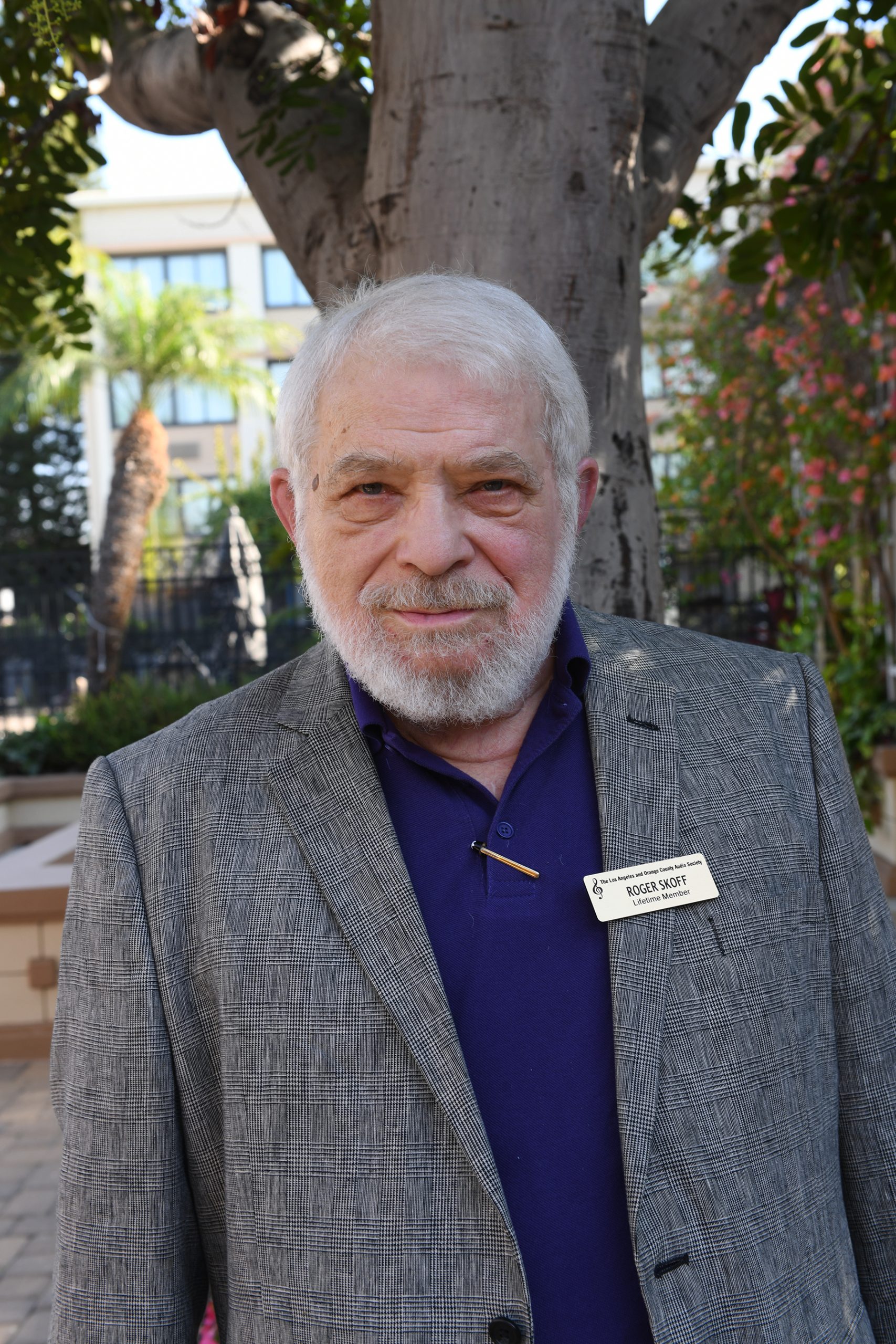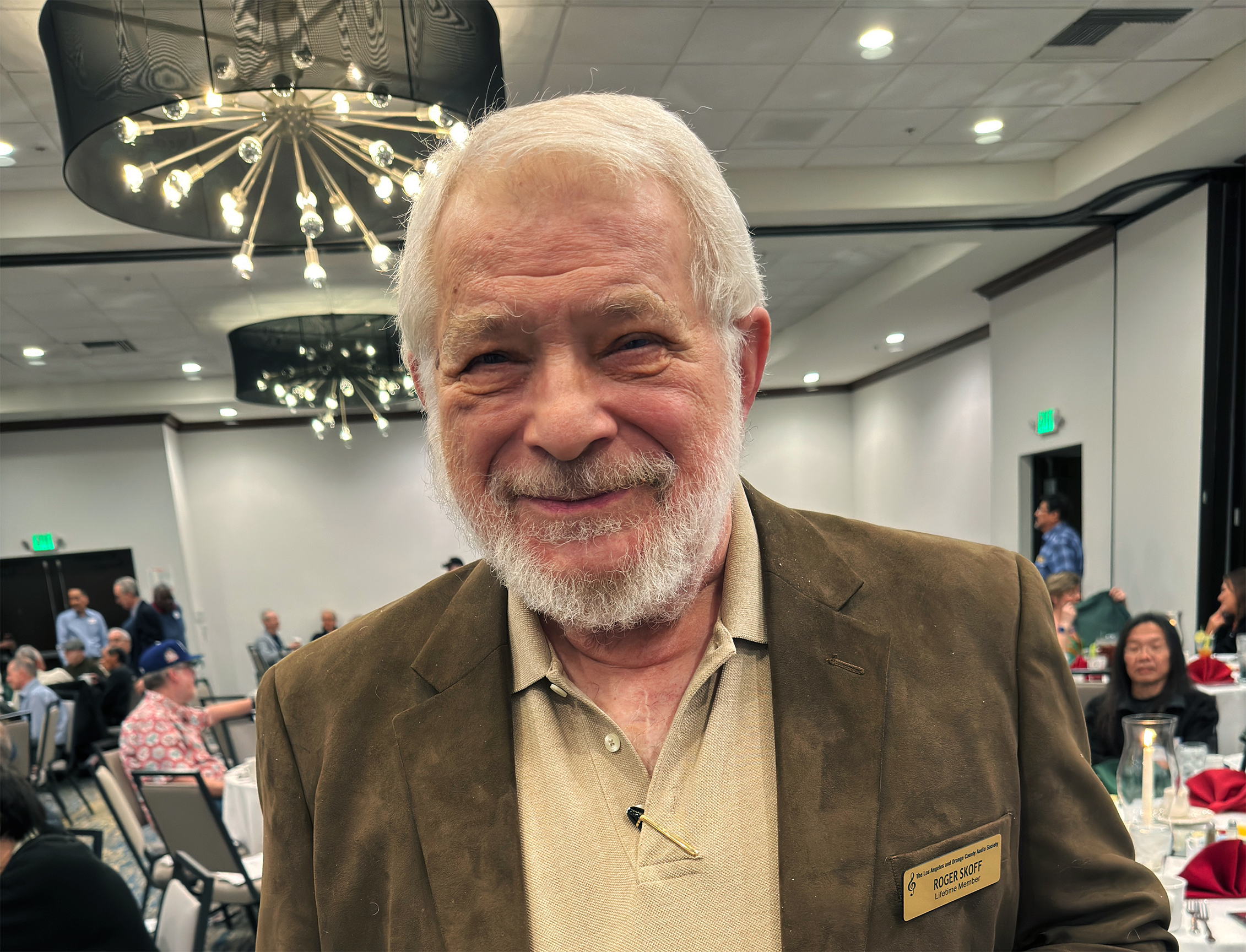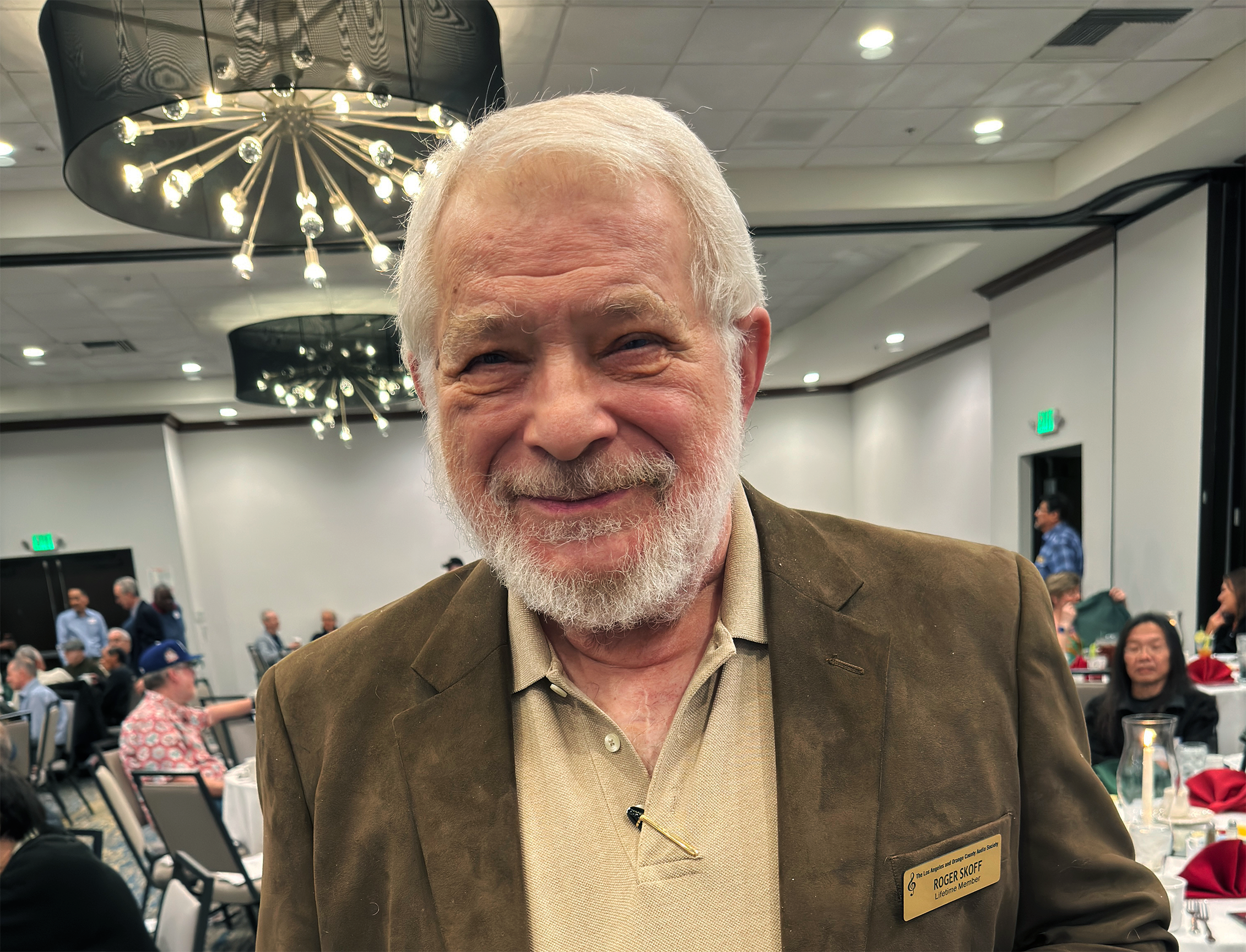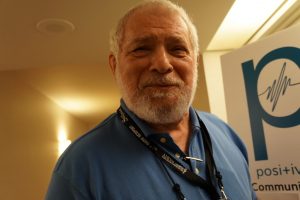
Chip and Roger at the LAOC Audio Society Gala Banquet, December, 2019 (photograph and image processing by David W. Robinson)
Roger Skoff finally proves that cables work and tells at least part of the reason why.
For at least the last thirty years (that I know of), audiophiles have been divided into four—if not necessarily warring, at least separate—camps on the subject of whether cables can actually affect the sound of a music system. There are those who hear performance differences and simply accept them without regard to how they might have come about; there are those who think they hear differences but dismiss them as "placebo effect" unless solidly backed by double-blind testing; there are those who call them "snake oil" or "Voodoo," and never even bother to listen, because either their "common sense" or their engineering degree has taught them that no such differences are possible; and, finally, there are those who don't believe in differences, either because their system or the way it's setup isn't good enough to present them, or because they don't know what to listen for (See my article "Make Listening a Skill" elsewhere in this issue), and simply never notice them.
I have to admit that I, too, was once one of the non-believers, and was of the school that says "cables are just wires to carry signal from one place to another, and 'wires is wires'." I learned better in the mid-1980s, when an audiophile friend of mine laughed at the ancient homemade cables that I had been using since I was a teenager, some thirty years before. (Beldens, at the time, nickel-a-foot microphone cable, terminated with, then two-for-a–nickel, tin-plated, cardboard-centered, "tulip-shaped" RCA connectors). He said that he had some good, modern cables out in the car, brought them in, hooked them up, and we both listened.
And, contrary to my wildest expectations, his cables sounded really a great deal different: They were far worse. The sound was not as well-defined; sonic "images" became blurry; the soundstage collapsed; and, for the first time, I knew in my heart that cables do make a difference!
That one experience showed me that wires aren't just wires, and set me off on a what has turned into a decades-long quest to learn how and why cables work, and why some sound better than others.
In doing that, the first thing I did was to hit the reference books: I read, quite literally, thousands of pages of information about cables—all of the conventional source material, plus most of the "Technical White Papers" of the then-popular High-End cable brands. What I learned could all be boiled down into just this: Cable performance is influenced by, and dependent on, just three things, resistance (R), capacitance (C), inductance (L), and may, under certain circumstances, also be influenced by characteristic impedance (Z0).
Resistance is nothing more than exactly what it sounds like—the degree to which a single conductor (a wire or anything else) will oppose the flow of electrical current. It is a constant, and (other than temperature) depends only on what the conductor is made of and how much of it there is. It's that simple.
Capacitance (the ability to store an electrical charge) and inductance (the ability of a conductor to induce opposing electromotive force in itself or another conductor as a result of a change in current flow) are a "seesaw" function, mutually determined by the positioning of a cable's (at least) two conductors: The closer they are together, the more capacitance there is and the less inductance; the farther apart they are, the more inductance and the less capacitance.
The above definitions are, of course, stated in their simplest possible form, but all of the texts and all of the papers agreed on them. The question they never answered, though, was "If it's the distance between conductors that creates the balance of capacitance and inductance, what creates the distance?"
The answer is so obvious that it's easy to overlook: It's the insulation!
Every cable has to consist of at least two conductors, one to carry the current from wherever it comes from to wherever it's going, and another to carry it back again, forming a complete "circuit," which must remain unbroken and uncompromised for current to flow. If either of the circuit paths (the conductors) is interrupted or not connected, the circuit is broken ("open"), and if the conductors touch each other anywhere along the way, the circuit is "shorted;" signal won't be carried; and equipment might be damaged. That's why every cable you'll ever use has at least one insulated wire—to keep the other wire from touching it—and most have insulation on both or all of their wires.
Whatever this insulation is made of, it has some thickness, and it's the total thickness of the insulation on the conductors (either one or both) that determines the minimum distance the conductors (the wires of the cable) can be apart. The maximum distance is a little harder to describe, but if the cable's wires are twisted together, that will set the maximum distance. And, even if the wires aren't twisted, cables almost always have some overall "jacket" to hold them together, and it's that jacket (also an insulator) that determines the conductors' maximum distance apart.
Whatever it is, it's some form of insulator that will determine the positioning of the conductors, and that's where the whole thing starts to get really interesting.
If we were to cut any bare (uninsulated) wire of any length off of any spool, and then cut another wire of exactly the same length off the exact same spool, we'd have two identical wires. And, if we were to measure the exact time that it took an electrical current to travel from one end of each of those wires to the other end, we could calculate the wires' velocity of propagation—the speed of current travel in that wire as a percentage of the speed of light. With two identical bare wires, the velocity of propagation ("VOP") would be identical.
But what would happen if we were to insulate those wires? The VOP would change. And if we were to insulate those same identical wires with different insulating materials, their VOPs would change differently.
How can that be? Isn't it the wire that carries the current (the "signal")? And isn't the insulator (doesn't it have to be?) a non-conductor? How can the insulation around a wire have any effect on current flow at all?
In fact, Maxwell (HERE) described an "electric field" around the wire that actually carries the signal, instead of the metal or the electrons of the conductor, itself. (Contrary to popular belief, the electrons, themselves, move very little, if at all. HERE). Comprising and complementing the electrical field surrounding a current-carrying insulated wire, two other fields are also present: a (current-controlled) electromagnetic field surrounding the wire, itself, and a (voltage-controlled), electrostatic field surrounding its insulation. It's the interaction of the fields around the insulated wire that effects the change in VOP brought about by the use of differing insulating materials.
It's also this field interaction that contributes to other changes to the signal passing through a cable, and thus affects the quality of transmission and the "sound" of the cable.
As with other interactions, not all are optimal and, in fact, only one relationship of the electromagnetic and electrostatic fields will produce the most nearly perfect signal transfer. Because the electromagnetic field is current-controlled and the electrostatic field is voltage-controlled, and because the ratios of current to voltage are different in every kind of audio application, different kinds of cables need to be designed and constructed differently to achieve the same optimum level of performance.
Carrying relatively high current at relatively low voltage, speaker cables require a different construction model for optimum field interaction than, for example, interconnects, which are completely the opposite, carrying relatively high levels of voltage at relatively low current. Phono cables—at least for modern moving coil, moving magnet, or moving iron cartridges, which may put out exceedingly little voltage at exceedingly little current—require still another kind of construction, as do AC power cords, which must potentially carry very large amounts of current at (at least as compared to those to be carried by other kinds of audio cables) very high voltage. This need to optimize field interactions was first recognized and made a major design consideration by my earlier company, XLO, and is now central to the designs of my current company, RSX Technologies, Inc. (HERE), which currently specializes only in phono cables and AC power cords, the very hardest kinds to get right.
All cables are capacitors (as are any two conductors surrounding a non-conductor) and all will, just like any other capacitor, store and release energy. This leads to another important contributor to the "sound" of a cable—the capacitive discharge effects arising from its dielectric (the insulating material between the two signal-carrying conductors), which is directly controlled by the material from which the dielectric is made.
These critical effects, which can either cancel musical detail or actually create out-of-of phase signal artifacts, were first made known to the audiophile community when Jonathan Scull interviewed me for Stereophile magazine sometime in the mid-to-late 1990s. (Sorry, but I don't remember the exact date or issue number.)
What happens to produce these effects is that, as a signal of whatever phase comes into a cable, some increment of it (determined by the dielectric constant (HERE) of the insulating material) is stored in the cable's dielectric and then, when the polarity of the incoming signal reverses (remember that a music signal is alternating current, constantly changing phase with the changes in the music), that stored energy is dumped into the signal path out-of-phase, either canceling a portion of the incoming signal or, if the released energy is greater than the incoming energy, causing an out-of-phase artifact. How audible this is likely to be depends on the dump rate of the dielectric material—the faster it is, the less likely the energy effects are to be perceived.
As with so many other things about cables, when capacitive discharge effects or the need to balance fields to optimize sonic performance were first announced, many greeted them as just that much more "snake oil" or manufacturer's hyperbole. The truth, though, is that they are just as much facts of physics as the easily-measurable differences in velocity of propagation brought about by changes in cable insulation, and are easy to hear by anyone with open ears, a clear mind, and a decent system.
Don't just take my word for it; go listen to a cable!
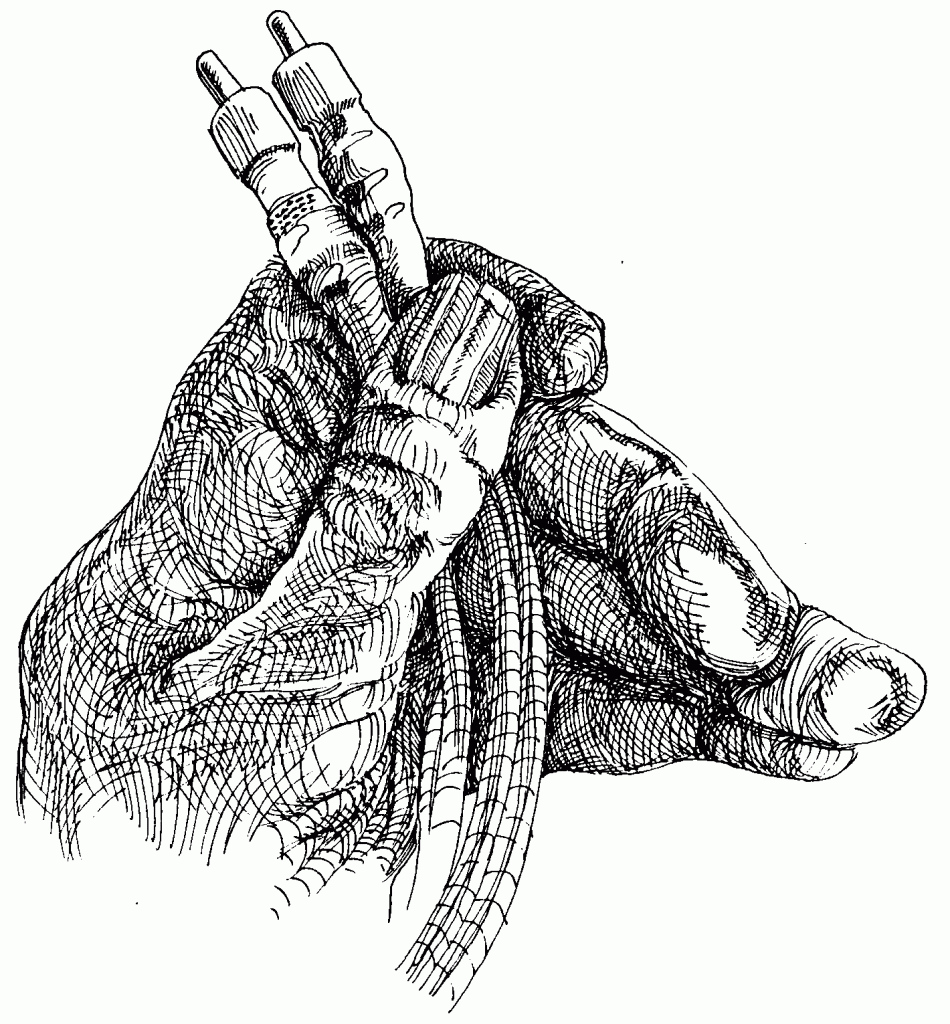
Drawing by Bruce Walker for Positive Feedback.




